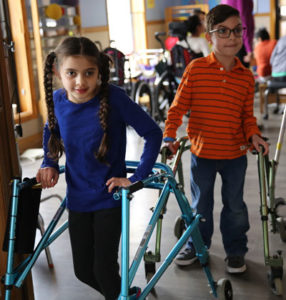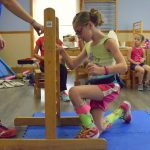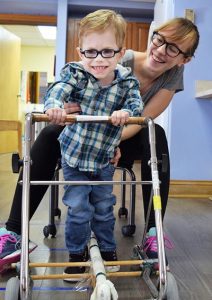Conductive Education
10 Principles of Neuroplasticity: Part 1
 Neuroplasticity – What is it and why does it matter?
Neuroplasticity – What is it and why does it matter?
Neuroplasticity (or neural plasticity) is a buzzword that is often used to advertise particular therapies or techniques, so-called “gurus” of neuroplasticity, or products. In order to make educated decisions about what kind of therapy will be most beneficial for your child, and to use your family income wisely, best to really know what this word means and why you need to care about it.
In this three-part series, I’m first going to define what neuroplasticity is, and introduce ten principles of neuroplasticity. In the next two parts, I’ll go into greater detail with each principle to help you understand what activities and experiences will make the biggest difference as it relates to neuroplasticity. The information I’ll present to you is based largely on research summarized in this article, titled “Principles of Experience-Dependent Neural Plasticity: Implications for Rehabilitation After Brain Damage.”1 If you want to do a deep dive into this concept, reading the full article is a great place to start.
So first, allow me to define Neuroplasticity. The term is a mash-up of two words.
Neural: relating to the nervous system
Plasticity: the capacity to adapt or change
In other words, it refers to the brain’s ability to change itself. As the authors of the article put it, “neural plasticity is the mechanism by which the brain encodes experience and learns new behaviors. It is also the mechanism by which the damaged brain learns lost behavior in response to rehabilitation.” Neuroplasticity is the process in which the brain forms new neurons and lays down new connections between neurons, in response to learning, in order to form a pathway to repeat the learned behavior.
This video does a great job of explaining how neuroplasticity works, too.
Neuroplasticity is a relatively new concept. As recently as a few decades ago, it was believed that our brains were “hardwired” and what we could and couldn’t do was essentially fixed, especially after a certain age, and certainly after an injury to the brain. Good news – researchers have found that this is not true!
However: neural plasticity does not happen In a vacuum. It is experience dependent, and some experiences are going to make a bigger difference than others.
Here’s where it gets interesting! Allow me to introduce you to the ten principles of neuroplasticity, the factors identified as especially important in facilitating neuroplasticity in the context of brain injury.
- Use it or lose it
Failure to drive specific brain functions can lead to loss of abilities. - Use it and improve it
Training that drives a specific brain function can lead to improving abilities. - Specificity
The nature of the training experience dictates the nature of the change in the brain (plasticity). - Repetition matters
Change (plasticity) requires sufficient repetition. - Intensity matters
Change (plasticity) requires intensive training. - Time matters
Different forms of change (plasticity) in the brain happen at different times during training. - Salience matters
The training experience must be meaningful to the person in order to cause change (plasticity). - Age matters
Training-induced change (plasticity) occurs more readily in younger brains. - Transference
Change in function as a result of one training experience can even lead to learning other similar skills. - Interference
Brain changes (plasticity) that result in bad habits can interfere with learning good habits.
Stay tuned for Part 2!
1. Kleim, JA, Jones, TA. (2008). Principles of experience-dependent neural plasticity: Implications for rehabilitation after brain damage. Journal of Speech, Language, and Hearing Research, 51, S225-S239.
Gravity and Cerebral Palsy: How it Affects your Child

Gravity is powerful.
You might be wondering: why is gravity special to people with cerebral palsy? Gravity affects everyone, right?
It’s true that gravity affects everyone. Gravity is where our muscle strength comes from. Think about typical development: all major milestones related to movement are different versions of working against gravity. Pushing up to hands and knees. Pulling to sit. Pulling to stand. Those are all movements against gravity, right? Gravity is the force that our muscles are pushing against, which is where muscle strength comes from. Think about how weak astronauts are when they return from a long trip outside the atmosphere: it’s because their muscles have very little opportunity to fight against something.
Gravity’s Affect on Individuals with Cerebral Palsy
Gravity affects kids with cerebral palsy in several ways. First, because their muscles aren’t quite as strong and have a harder time coordinating, it’s harder to fight against gravity to complete those major milestones. As a result, kids with CP spend more time in positions that are gravity dependent. This means that unless the right positioning equipment is used, young kids with CP tend to spend more time either lying down or lying back in a reclined position. This simple factor of not being in an upright position can have lasting effects on alignment. Did you know that this affects rib cage development? When we are born, our ribs are in a horizontal position. As we move through typical milestones to be able to sit and stand, gravity pulls our ribs so they angle down. Go ahead – feel your ribs right now and you’ll feel that they are pointing down. This is the ideal position for our ribs to support our lungs as they move out and in for normal breathing. If kids with cerebral palsy aren’t given the opportunity to be in an upright position as they grow, the ribs will stay horizontal which makes breathing harder.
Another major way that gravity affects many kids with CP is later in life during walking. “Crouch gait” is a very common feature of CP, and it’s pretty much what it sounds like: the child walks with their knees bent. There are several causes for this type of walking pattern, like growth spurts and spasticity, but gravity is also a major influence. Because gravity is pulling the body down, the knees bend, and leg muscles have to be strong enough to overcome that pull. Since kids with CP tend to have weaker muscles, gravity might be so strong that the knees are not able to straighten out.
Those are just two of the biggest ways that gravity affects kids with CP, but there are so many more since every movement we do is done against gravity (unless we are swimming, or happen to be in outer space!). Even if we are just sitting, our head and torso need to work to stay upright.
So what do we do about it?
The first thing is to be sure to get the right equipment from an early age. Children who are not sitting by 6 months should get adaptive equipment to allow them to sit upright, and if they are not standing by 12 months they should get equipment that supports them in a standing position.1 Adaptive equipment will allow them to be positioned against gravity, which not only supports correct rib cage alignment, but also helps them work on trunk and neck control, and allows them some opportunity to bear weight to help keep their bones strong.
The second thing is, of course, therapy! An intense motor program like what is offered at the Center for Independence will work on strengthening muscles to be able to overcome gravity and will address their ability to do all the antigravity movements of pulling to sit, pulling to stand, walking, and so on.
Share Your Thoughts on This Topic
- Have you ever thought about how gravity affects your child’s movement and alignment?
- Does this change how you think about using equipment with your child?
- What questions do you have about this concept?
Share your thoughts on our Facebook page!
Sources: 1. Gericke, T. (2006). Postural management for children with cerebral palsy: Consensus statement. Developmental Medicine & Child Neurology, 48, 244.
When is the Critical Time for Children with CP?
 Have you considered that there is a critical time for therapy for children with cerebral palsy (CP)?
Have you considered that there is a critical time for therapy for children with cerebral palsy (CP)?
From the ages of about zero to three, and again in puberty, children’s bodies and brains grow quickly. Intense therapy is important during those both of those times.
A Few Reasons Why:
It’s normal for bones to grow faster than muscles during growth spurts. This is where growing pains come from! In kids who don’t have CP, their muscles will eventually catch up in length. Spasticity makes this much harder for kids who do have CP, and those muscles get tighter and tighter during rapid growth. It’s so important to keep muscles as flexible as possible, because it’s really hard to fix once they get tight.
When kids grow bigger, their bodies get longer and heavier. Bigger bodies are harder to move and things that used to be easy become harder. Skills have to be practiced regularly, otherwise they might be lost.
Kids brains are growing rapidly during the ages of zero to three and again in puberty. This is the best time to practice good movement patterns! The brain is ready to learn and will remember things that are practiced in these times best. This is the aim of Conductive Education, which is founded on the premise of neural plasticity.
Critical Times Can Be Easily Missed
If a child with CP isn’t diagnosed soon enough, they might not start therapy early enough. If the child gets discharged from therapy when they are doing well right before puberty hits, they might not get therapy when they need it the most.
Karen Pape discusses these concepts in her book, The Boy Who Could Run But Not Walk: Understanding Neuroplasticity in the Child’s Brain:
“Diagnosis-specific treatment should be available during the important first four years of exuberant body and brain growth. There is no logical reason to wait. This is the time when there is the best possible chance for normalizing function.” 209
“Convince a teenager that the intensive, purposeful practice is worth it and he will improve, usually by one or two levels of function. It is a golden opportunity. This period, then, is a prime opportunity to work around established maladaptive habits.” 243
Share Your Thoughts on This Topic
Here are some questions to get the discussion going:
- Did you know about these critical times for therapy?
- What do you think can get in the way of getting therapy during these windows?
- What changes have you seen in your own child during these phases?
- How can we at the Center help support your goals for your child during these times?
Find us on our Facebook page to share you thoughts.
